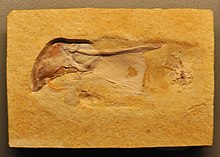
An octopus is a soft-bodied, eight-limbed mollusc of the order Octopoda. The order consists of some 300 species and is grouped within the class Cephalopoda with squids, cuttlefish, and nautiloids. Like other cephalopods, an octopus is bilaterally symmetric with two eyes and a beaked mouth at the center point of the eight limbs. The soft body can radically alter its shape, enabling octopuses to squeeze through small gaps. They trail their eight appendages behind them as they swim. The siphon is used both for respiration and for locomotion, by expelling a jet of water. Octopuses have a complex nervous system and excellent sight, and are among the most intelligent and behaviourally diverse of all invertebrates.

A squid is a mollusc with an elongated soft body, large eyes, eight arms, and two tentacles in the superorder Decapodiformes, though many other molluscs within the broader Neocoleoidea are also called squid despite not strictly fitting these criteria. Like all other cephalopods, squid have a distinct head, bilateral symmetry, and a mantle. They are mainly soft-bodied, like octopuses, but have a small internal skeleton in the form of a rod-like gladius or pen, made of chitin.

A cephalopod is any member of the molluscan class Cephalopoda such as a squid, octopus, cuttlefish, or nautilus. These exclusively marine animals are characterized by bilateral body symmetry, a prominent head, and a set of arms or tentacles modified from the primitive molluscan foot. Fishers sometimes call cephalopods "inkfish", referring to their common ability to squirt ink. The study of cephalopods is a branch of malacology known as teuthology.

The vampire squid is a small cephalopod found throughout temperate and tropical oceans in extreme deep sea conditions. The vampire squid uses its bioluminescent organs and its unique oxygen metabolism to thrive in the parts of the ocean with the lowest concentrations of oxygen. It has two long retractile filaments, located between the first two pairs of arms on its dorsal side, which distinguish it from both octopuses and squids, and places it in its own order, Vampyromorphida, although its closest relatives are octopods. As a phylogenetic relict, it is the only known surviving member of its order.

Coleoidea or Dibranchiata is one of the two subclasses of cephalopods containing all the various taxa popularly thought of as "soft-bodied" or "shell-less". Unlike its extant sister group Nautiloidea, whose members have a rigid outer shell for protection, the coleoids have at most an internal shell called cuttlebone or gladius that is used for buoyancy or as muscle anchorage. Some species, notably incirrate octopuses, have lost their internal shell altogether, while in some it has been replaced by a chitinous support structure. A unique trait of the group is the ability to edit their own RNA.

Belemnoids are an extinct group of marine cephalopod, very similar in many ways to the modern squid. Like them, the belemnoids possessed an ink sac, but, unlike the squid, they possessed ten arms of roughly equal length, and no tentacles. The name "belemnoid" comes from the Greek word βέλεμνον, belemnon meaning "a dart or arrow" and the Greek word είδος, eidos meaning "form".

Octopodiformes is a superorder of the subclass Coleoidea, comprising the octopuses and the vampire squid. All living members of Octopodiformes have eight arms, either lacking the two tentacles of squid or modifying the tentacles into thin filaments. Octopodiformes is often considered the crown group of octopuses and vampire squids, including all descendants of their common ancestor. Some authors use the term Vampyropoda for the same general category, though others use "Vampyropoda" to refer to the total group. Another term is Octobranchia, referring to cephalopods without prominent tentacles.
Pohlsepia mazonensis is a species of fossil organism with unknown affinity. Although it was originally identified as an extinct cephalopod, later studies denied that interpretation. The species is known from a single exceptionally preserved fossil discovered in the late Carboniferous (Pennsylvanian) Francis Creek Shale of the Carbondale Formation, north-east Illinois, United States.
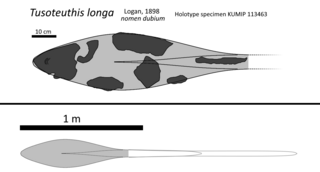
Tusoteuthis is an extinct genus of large enchoteuthine cephalopod that lived during the Cretaceous. Although often called a squid, it is now thought to be more closely related to modern octopuses. Although many specimens from Western Interior Seaway of North America were described, at 2019, only one, poorly preserved specimen from Kansas is recognized as Tusoteuthis. One species, T. longa, is traditionally recognized. In 2019, due to poor preservation of holotype specimen, Tusoteuthis was considered likely to be a nomen dubium, and it was proposed that later described species are better to included in genus Enchoteuthis instead.
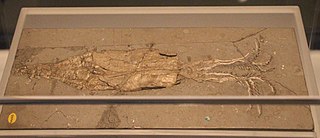
Belemnotheutis is an extinct coleoid cephalopod genus from the middle and upper Jurassic, related to but morphologically distinct from belemnites. Belemnotheutis fossils are some of the best preserved among coleoids. Remains of soft tissue are well-documented in some specimens, even down to microscopic muscle tissue. In 2008, a group of paleontologists even recovered viable ink from ink sacs found in several specimens.
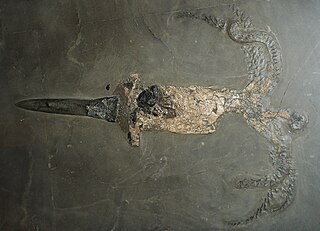
Belemnitida is an extinct order of squid-like cephalopods that existed from the Late Triassic to Late Cretaceous. Unlike squid, belemnites had an internal skeleton that made up the cone. The parts are, from the arms-most to the tip: the tongue-shaped pro-ostracum, the conical phragmocone, and the pointy guard. The calcitic guard is the most common belemnite remain. Belemnites, in life, are thought to have had 10 hooked arms and a pair of fins on the guard. The chitinous hooks were usually no bigger than 5 mm (0.20 in), though a belemnite could have had between 100 and 800 hooks in total, using them to stab and hold onto prey.
Stauroteuthis gilchristi is a species of small pelagic octopus found at great depths in the south Atlantic Ocean. It is believed to be one of a very small number of octopuses to exhibit bioluminescence, like its sister taxon Stauroteuthis syrtensis.
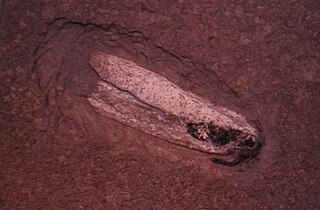
The gladius, or pen, is a hard internal bodypart found in many cephalopods of the superorder Decapodiformes and in a single extant member of the Octopodiformes, the vampire squid. It is so named for its superficial resemblance to the Roman short sword of the same name, and is a vestige of the ancestral mollusc shell, which was external. The gladius is located dorsally within the mantle and usually extends for its entire length. Composed primarily of chitin, it lies within the shell sac, which is responsible for its secretion. Some species, like the bigfin reef squid, still has a gladius with some degree of mineralization.

Cirrate octopuses possess a well-developed internal shell that supports their muscular swimming fins. This is in contrast to the more familiar, finless, incirrate octopuses, in which the shell remnant is either present as a pair of stylets or absent altogether.
Cryptoteuthis brevibracchiata, the short-arm flapjack octopod, is a deepwater species of octopod. It is the only species in the monotypic genus Cryptoteuthis one of the cirrate octopuses of the family Grimpoteuthidae, the umbrella octopuses. It is known from a single specimen which was collected in the northeastern Atlantic Ocean. It has characteristics which are shared with two other genera, Opisthoteuthis and Grimpoteuthis, but is sufficiently distinctive from either of these to warrant the erection of a new genus.
Grimpoteuthis challengeri is a species of large octopus living in the abyssal zone.

Muensterellidae is a family of stem-octopod cephalopods from the Late Jurassic to Late Cretaceous.

Enchoteuthis is an extinct genus of large enchoteuthine cephalopod that lived during the Cretaceous. Although it and its relative Tusoteuthis are often compared to squid, both are now thought to be more closely related to modern octopuses. Examination of gladius remains initially yielded an estimated mantle length about 2 m based on specimen once described as Tusoteuthis longa, close to or equal to that of the modern giant squid, although reclassification of this genus as a muensterelloid results in a much shorter total length, about 3 m (10 ft). Three species are currently recognized as valid: E. melanae, E. tonii, and E. cobbani.

The Teudopseina is a clade of stem-octopods that first evolved in the Toarcian, considered the largest clade of gladius-bearing coleoids in the Mesozoic. Up to five families are known, among which the Trachyteuthidae, Trachyteuthis in particular, were the most abundant.
Patelloctopodidae is a family of stem-octopod cephalopods from the Middle and Late Jurassic of Europe. Five genera are currently placed in the family, Etchesia, Muenstellerina,Patelloctopus,Pearciteuthis and Tyrionella, Patelloctopodidae is one of two families in the superfamily Muensterelloidea along with the Muensterellidae. They are thought to be the group from which modern octopus arose.
